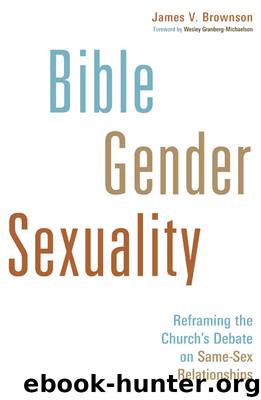Bible, Gender, Sexuality by Brownson James V

Author:Brownson, James V.
Language: eng
Format: epub
Publisher: Wm. B. Eerdmans Publishing, Co.
Summing Up
Paul clearly expects his readers to join him in outrage over the sexual behavior he describes in Romans 1:24-27 as an expression of excessive, self-centered desire. He describes this behavior as an expression of “lusts” (1:24), as driven by “passions” (1:26), and as “consumed, or “burning,” “with passion” (1:27).
This is in keeping with the general perception of same-sex relations in the ancient world: that they were driven by insatiable desire, not content with more normal sexual relationships. Jews and Christians opposed to same-sex eroticism show no awareness of the modern notion of sexual orientation.
In Romans 1:24-27, Paul may be alluding to the notorious excesses of a former Roman emperor, Gaius Caligula, whose idolatrous patterns and sexual excesses — including same-sex eroticism — were well known, and whose murder by being stabbed in the genitals markedly echoes Paul’s words in Romans 1:27: “receiving in their own persons the due penalty for their error.”
Paul does not regard sexual desire itself as evil; it is only when desire gets out of control that it becomes lust and leads to sin.
Many traditionalist interpreters of this passage focus on the “objective” disorder of same-sex relationships, but when Paul speaks of these behaviors as “lustful,” the focus falls on their excessive nature: out-of-control, self-seeking desire.
Modern attempts to differentiate between same-sex orientation and same-sex behavior tend to minimize Paul’s concern with out-of-control lust in this text, focusing instead on the “objective” disorder of same-sex intimacy. Yet this move leaves gay and lesbian Christians with little help in wrestling with their “subjective” sexual orientation, which is in most cases highly resistant to change.
Ultimately, Scripture does not sanction a sharp split between sinful acts and the inclination toward sinful acts. If an act is sinful, the inclination to that act is also a manifestation of one’s sinful nature. This calls into question whether the orientation/behavior dichotomy in many traditionalist approaches to homosexuality is theologically and ethically viable.
But if we keep Paul’s focus in Romans 1:24-27 on out-of-control desire firmly in focus, we will recognize that these concerns may not be reflected in committed gay or lesbian relationships, opening up the possibility that these relationships may not be “lustful” and thus not directly addressed by Paul’s polemic in Romans 1.
Download
This site does not store any files on its server. We only index and link to content provided by other sites. Please contact the content providers to delete copyright contents if any and email us, we'll remove relevant links or contents immediately.
The Five People You Meet in Heaven by Mitch Albom(2842)
Name Book, The: Over 10,000 Names--Their Meanings, Origins, and Spiritual Significance by Astoria Dorothy(2490)
Real Sex by Lauren F. Winner(2475)
The Holy Spirit by Billy Graham(2418)
The Secret Power of Speaking God's Word by Joyce Meyer(2253)
0041152001443424520 .pdf by Unknown(2220)
How The Mind Works by Steven Pinker(2213)
Ancient Worlds by Michael Scott(2103)
ESV Study Bible by Crossway(2097)
The Meaning of the Library by unknow(2069)
The Gnostic Gospels by Pagels Elaine(2026)
Churchill by Paul Johnson(2012)
MOSES THE EGYPTIAN by Jan Assmann(1972)
The ESV Study Bible by Crossway Bibles(1915)
Jesus by Paul Johnson(1887)
The Nativity by Geza Vermes(1849)
Ancient Near Eastern Thought and the Old Testament by John H. Walton(1846)
The Complete Dead Sea Scrolls in English (7th Edition) (Penguin Classics) by Geza Vermes(1840)
City of Stairs by Robert Jackson Bennett(1826)
